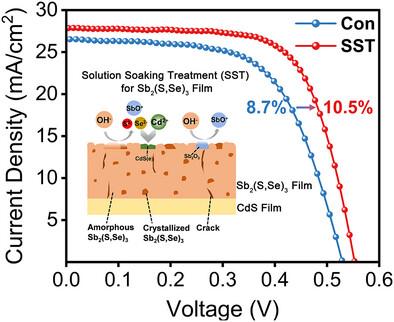Manipulating Atomic and Microstructure of Sb2(S,Se)3 Thin Films via a Novel Post-Treatment for Efficient Solar Cell Application
IF 26
1区 材料科学
Q1 CHEMISTRY, PHYSICAL
引用次数: 0
Abstract
Antimony selenosulfide (Sb2(S,Se)3), an emerging light-harvesting material, exhibits a high light absorption coefficient, low toxicity, and phase stability. However, Sb2(S,Se)3 films deposited via the conventional hydrothermal method fail to achieve desirable optoelectronic properties and crystallinity, which ultimately hinders their applications in photovoltaic devices. In this study, an innovative post-treatment process is developed, wherein the Sb2(S,Se)3 absorber is soaked in a mixed aqueous solution containing ammonia, sodium citrate, and cadmium sulfate, followed by annealing, resulting in multi-dimensional optimization. It is revealed that the synergistic interaction in this strategy leads to the formation of cadmium selenide and cadmium sulfide on the surface and the infiltration of cadmium ions into the bulk phase. This outcome finally optimizes the atomic structure by passivating the deep-level defects such as Se and S vacancy, while also increasing the crystallinity through a strong chemical bonding effect. Furthermore, the slight etching of the surface by ammonia reduces the content of antimony oxide, increases phase purity, and optimizes interfacial contact in the device, thereby facilitating carrier transport. With these advantages, a high power conversion efficiency of 10.5% for Sb2(S,Se)3 solar cell is achieved. This study provides a one-stone-for-three-birds strategy for improving the photoelectric performance of antimony-based chalcogenide compounds.

利用新型后处理技术控制Sb2(S,Se)3薄膜的原子和微观结构,用于高效太阳能电池
硒化硫化锑(Sb2(S,Se)3)是一种新兴的光收集材料,具有高光吸收系数、低毒性和相稳定性。然而,通过传统的水热法沉积的Sb2(S,Se)3薄膜无法获得理想的光电性能和结晶度,最终阻碍了其在光伏器件中的应用。在本研究中,开发了一种创新的后处理工艺,将Sb2(S,Se)3吸收剂浸泡在含有氨、柠檬酸钠和硫酸镉的混合水溶液中,然后退火,进行多维优化。结果表明,该策略的协同作用导致了表面硒化镉和硫化镉的形成以及镉离子向体相的渗透。该结果最终通过钝化Se和S空位等深层缺陷来优化原子结构,同时通过强化学键效应提高结晶度。此外,氨对表面的轻微蚀刻降低了氧化锑的含量,提高了相纯度,优化了器件中的界面接触,从而促进了载流子的运输。利用这些优点,实现了Sb2(S,Se)3太阳能电池高达10.5%的功率转换效率。本研究为提高锑基硫系化合物的光电性能提供了一石三鸟的策略。
本文章由计算机程序翻译,如有差异,请以英文原文为准。
求助全文
约1分钟内获得全文
求助全文
来源期刊

Advanced Energy Materials
CHEMISTRY, PHYSICAL-ENERGY & FUELS
CiteScore
41.90
自引率
4.00%
发文量
889
审稿时长
1.4 months
期刊介绍:
Established in 2011, Advanced Energy Materials is an international, interdisciplinary, English-language journal that focuses on materials used in energy harvesting, conversion, and storage. It is regarded as a top-quality journal alongside Advanced Materials, Advanced Functional Materials, and Small.
With a 2022 Impact Factor of 27.8, Advanced Energy Materials is considered a prime source for the best energy-related research. The journal covers a wide range of topics in energy-related research, including organic and inorganic photovoltaics, batteries and supercapacitors, fuel cells, hydrogen generation and storage, thermoelectrics, water splitting and photocatalysis, solar fuels and thermosolar power, magnetocalorics, and piezoelectronics.
The readership of Advanced Energy Materials includes materials scientists, chemists, physicists, and engineers in both academia and industry. The journal is indexed in various databases and collections, such as Advanced Technologies & Aerospace Database, FIZ Karlsruhe, INSPEC (IET), Science Citation Index Expanded, Technology Collection, and Web of Science, among others.
 求助内容:
求助内容: 应助结果提醒方式:
应助结果提醒方式:


